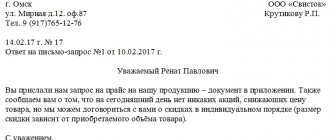What is NDA
This is a non-disclosure agreement - from the English non-disclosure agreement.
It helps prevent the leakage of important information that should not fall into the wrong hands. For example, a company is hiring a sales manager. He is given access to a client base that has been accumulated over the years. An employee could quit tomorrow and take the data to competitors. To prevent this from happening, an NDA is signed.
An agreement can also be concluded with a counterparty. Let's say an organization finds a contractor company. She must develop an advertising campaign for a new, still secret product. The contractor will receive information about the product, but should not distribute it ahead of time. Again, the NDA should motivate the contractor’s employees to remain silent.
What information can be protected by an NDA?
In Russia, confidential information includes several types of information. This could be state or official secrets, personal data, and so on. They are protected by relevant regulations. As for NDA, we are, as a rule, talking about a trade secret Federal Law of July 29, 2004 No. 98-FZ.
By law, you can protect information that is valuable precisely because it is unknown to third parties. For example, an organization plans to launch a unique product on the market. If the technology for its development becomes known, competitors may make a similar product - and at the same time as the original. This means that the company risks losing profits. Therefore, the development technology can definitely be a trade secret.
At the same time, there is a fairly large Federal Law of July 29, 2004 No. 98-FZ, a list of data that cannot be classified. This is, for example, information about the number and composition of personnel, the payment system and working conditions. You can read more in Lifehacker’s material about trade secrets. If you try to prohibit the disclosure of this information in the NDA, the document will be easy to challenge in court.
An NDA can include an obligation to keep secret other information that the parties consider confidential, even if it is not protected by law. But only if regulations do not prohibit this.
Agreement on non-disclosure of trade secrets
Agreement No. 1 on non-disclosure of trade secrets, Moscow 01/30/2015. ________________________________, hereinafter referred to as the “Employer” represented by the General Director _______________________________________________, acting on the basis of the Charter, on the one hand, and Ivan Ivanovich Ivanov, hereinafter referred to as the “Employee”, on the other hand, and together the “Parties”, have entered into this agreement as follows : 1.Basic concepts. 1) trade secret - a regime of confidentiality of information that allows its owner, under existing or possible circumstances, to increase income, avoid unjustified expenses, maintain a position in the market for goods, works, services or obtain other commercial benefits; 2) information constituting a trade secret - information of any nature (production, technical, economic, organizational and others), including the results of intellectual activity in the scientific and technical field, as well as information about methods of carrying out professional activities that have valid or potential commercial value due to their unknownness to third parties, to which third parties do not have free access legally and in respect of which the owner of such information has introduced a trade secret regime; 3) holder of information constituting a trade secret - an employee who possesses information constituting a trade secret on a legal basis, has limited access to this information and has established a trade secret regime in relation to it; 4) access to information constituting a trade secret - familiarization of an employee with information constituting a trade secret, with the consent of its owner or on another legal basis, subject to maintaining the confidentiality of this information; 5) counterparty - a party to a civil contract to whom the owner of information constituting a trade secret transferred this information. 6) disclosure of information constituting a trade secret - an action or inaction as a result of which information constituting a trade secret in any possible form (oral, written, other form, including using technical means) becomes known to third parties without the consent of the employer . 2. Subject of the agreement 2.1. This agreement governs the relations of the Parties related to the establishment, change and termination of the trade secret regime in relation to information constituting the secret of the employer’s work methods, drilling methods, client base, list of contractors, partners, suppliers and other information specified in The provision on trade secrets applies to information constituting a trade secret, regardless of the type of media on which it is recorded. “Trade Secrets” shall be collectively defined as any or all, present or future, technical, financial, business information, statistics, data, designs, plans, specifications, documents, trade secrets, ideas, concepts, products, processes, technologies, prices and other confidential and proprietary information of the Disclosing Party, whether orally, written, printed or in any other form, in any medium, communicated to the Receiving Party that is or is not marked, identified or not identified as confidential or proprietary, but which has been communicated as such. one of the Parties in connection with negotiations regarding business, finance, products, facilities or concepts. 2.2. This agreement does not regulate the relations of the Parties related to state secrets, in respect of which the provisions of the legislation of the Russian Federation on state secrets apply. 3.List of information constituting a trade secret. 3.1. Information about the economic strategy and tactics of the enterprise, about accounts receivable/payable, about the economic efficiency of the enterprise, about the pricing procedure for products sold, about the presence/number of bank accounts of the enterprise and cash flows through them, about economic indicators and business plans of the enterprise and other economic characteristics. 3.2. Any information containing new ideas, business concepts, ways to solve trade and implementation problems, problems and difficulties of any nature. 3.3. Tactics for conducting sales negotiations, information about the methodology and results of calculating competitive prices, information about the number of counterparties of the enterprise. 3.4. Information regarding the enterprise’s legal proceedings, document flow procedures, office work, the level of qualifications of employees, patents, inventions, rationalization solutions, methods of organizing and protecting computer databases. 3.5. Channels for obtaining information, business connections, methods of cooperation with other companies, information about the business reputation of the enterprise and other information. 3.6. Data about partners, parties to contracts, namely identification information, including TIN, KPP, OKVED codes, information about current accounts, information contained in their statutory documents, etc. 3.7. Data on negotiations: information on received and proposed orders and proposals; Business correspondence; Information about the facts of preparation and conduct of negotiations; Contents of closed meetings and negotiations; Information about persons conducting negotiations, management of third-party companies, their characteristics; Materials and applications received/transmitted during the negotiation process. 3.8. Personnel structure and organization of activities: Lists of the Company’s employees, and samples of their signatures; The procedure for organizing labor in the Company; Information about the security system in the Company; Information about access control in the Company; Passes and certificates of the Company's employees; Keys to the Company's premises, safes and storage rooms; 3.9.Finance: Information on credits (loans) issued or received by the Company; Information about the Company's financial flows, their volume and directions. 3.10.Documentation: Contents of business plans, financial risks, forecast estimates; Primary accounting documents and interim financial reports; Accounting registers, internal accounting reporting. Information on the execution of contracts and agreements; Results of scientific research and design developments carried out by the Company’s employees or relevant organizations under agreement with the Company; Storage media containing classified information (floppy disks, disks, printouts, copies, etc.); Inventions, new ideas and know-how; (practically applicable non-patented commercial, organizational and other knowledge and experience, the possession of which provides a certain economic benefit); Information about work on an invention or proposal before filing an application for state registration of the invention or proposal. 3.11. Technical information: information about passwords, keys and other secret elements for access to work with programs and other information of the Company; Information about the Company's electronic document management system with third parties; Information about the identification and authentication system for the Company’s employees related to access: to the Company’s local network; to the Company's mail server; to the mail programs of the Company's employees; to personal computers; to the means of protecting the Company's information. 3.12. Information about the Company’s employees: Personal data of the Company’s employees; confidential information about the Company's employees, their family members, home and personal mobile phones and addresses; information about personal vehicles owned by employees; Other information classified as confidential in accordance with the Labor Code of the Russian Federation. 3.13.The list of information specified in this agreement is not exhaustive. Commercial information is any information received from the Employer or as a result of work activities from other persons. 4. Rights and obligations of the parties 4.1. All information that constitutes a trade secret in accordance with this Agreement and became known to the employee as a result of communication with the Employer is confidential, and the Receiving Party undertakes not to disclose it. 4.2. The Employee undertakes to protect information that constitutes a trade secret of the Disclosing Party and has become known to it as a result of cooperation, from any encroachment and attempts to make it public by third parties. 4.3. The employee undertakes to use the information obtained as a result of work activities only for the purposes of this cooperation. 4.4. The employee undertakes, after termination of employment with the employer, not to use information obtained as a result of work for the purpose of competition with another party. 4.5. All information that constitutes a trade secret and received by the parties as a result of their work activities in the form of letters, emails, reports, records, photographs, drawings in tangible or intangible form is the property of the Employer and is used only within the framework and on the terms of this Agreement with the Employer. 4.6. Under this Agreement, the Employee does not receive any rights to the Employer's intellectual property. 4.7. In the event of disclosure of information constituting a trade secret under this Agreement: – The Employee is obliged to compensate for all losses incurred as a result of such disclosure, the amount of which is determined in accordance with the legislation of the Russian Federation, taking into account the losses and lost profits of the Employer, taking into account all benefits received by a third party in receiving a trade secret from an employee as a lost profit of the Employer. –The employee is warned that, in accordance with the legislation of the Russian Federation, disclosure of information constituting a trade secret may entail civil, administrative and criminal liability. 4.8. For the disclosure of information constituting a trade secret, the employer has the right to dismiss the employee for this violation. 5. Protecting the confidentiality of information 5. 1. Measures to protect the confidentiality of information should include: 1) Determining the list of information that constitutes a trade secret. This list is established in this agreement and can be supplemented by the provision on trade secrets in the organization. 2) Limiting access to information constituting a trade secret by establishing a procedure for handling this information and monitoring compliance with such a procedure. 3) Accounting for persons who received access to information constituting a trade secret and (or) persons to whom such information was provided or transferred. 4) Regulation of relations regarding the use of information constituting a trade secret by employees on the basis of employment contracts and by contractors on the basis of civil law contracts. 5) Applying on tangible media (documents) containing information constituting a trade secret, the stamp “Trade Secret” indicating the owner of this information (for legal entities - full name and location). 5.2. The trade secret regime is considered established after the above measures are taken. 5.3. Along with the above measures, it is possible to use means and methods of technical protection of the confidentiality of this information, and other measures that do not contradict the legislation of the Russian Federation. 6. Rules for handling information constituting a trade secret. 6.1.The employee is obliged to take maximum care when working with information received from the employer or other persons interacting with the Employer, in order to prevent other persons from obtaining this information. 6.2. Copying of any information, both on paper and digital, is carried out with the permission of the Employer. It is allowed to copy information without the employer’s permission only if it is necessary for work activities (for example, when submitting reports to the Federal Tax Service). If it is established that another person has received a copy of the information medium, the employee is obliged to compensate for the damage caused to the Employer. 7. Duration of the Agreement 7.1. This Agreement comes into force from the moment it is signed by the Parties and is valid indefinitely, including upon termination of the employment relationship. 8. Other conditions 8.1. The parties to this agreement are explained and aware of the criminal liability provided for in Art. 183 of the Criminal Code of the Russian Federation for “Illegal receipt and disclosure of information constituting commercial, tax or banking secrets.” 8.2. Upon signing this agreement, the employee is entered into the register of persons carrying out activities using trade secrets. 8.3. Employees are provided with all guarantees for non-disclosure of information through no fault of the employee. 8.3. This agreement is terminated with the termination of the employment relationship between the Parties under employment contract No. ____ dated ___.01.2015. 8.4. In the event of termination of an employment contract with the Employer and subject to employment in a competing organization, the Charter of which includes similar OKVED regulations of the employer, the employee is obliged to notify the Employer of such employment; failure to comply with the notification conditions releases the Employer from proving the disclosure of trade secrets by the employee. 8.4. If the notification conditions specified in clause 8.4 are not met. within 30 days from the date of concluding an employment contract with another organization, the employee is obliged to pay a fine to the employer in the amount of 100,000 (one hundred thousand) rubles. Please check the spelling of these two paragraphs 9. Special conditions 9.1. All changes and additions to this Agreement are valid only if they are made in writing and signed by both Parties. 9.2. In case of disputes and disagreements under this Agreement, the Parties will take all possible measures to resolve the dispute through negotiations. In the event of irresolvable contradictions between the Parties, the dispute is subject to final resolution in court in accordance with the legislation of the Russian Federation. 9.3. This Agreement is drawn up in two copies, one copy for each party. Both copies have the same legal force. 10. Signatures of the parties
What to do before writing an NDA
The document will be useless if the entire procedure for introducing a trade secret regime in an organization is not followed. Any little thing can lead to the court not finding the Resolution dated July 3, 2015. Case No. A56‑72074/2014 violations of confidentiality. Therefore, you first need to create the infrastructure Federal Law of July 29, 2004 No. 98-FZ for concluding a non-disclosure agreement.
The Lifehacker Telegram channel contains only the best texts about technology, relationships, sports, cinema and much more. Subscribe!
Our Pinterest contains only the best texts about relationships, sports, cinema, health and much more. Subscribe!
Determine what information you will protect
Here you need to think carefully about everything in order to get a specific list of data that cannot be disclosed. You should not get away with general formulations like “everything that will become known in the course of work” - the court will not be satisfied with this Resolution of the Federal Arbitration Court of the Volga District of July 29, 2013 No. F06-5778/13 in case No. A65-9864/2012. You need specifics like this:
- information about the production capabilities of the enterprise;
- data on raw material reserves;
- enterprise development plans;
- purchasing and sales plans.
Subsequently, the results of the reflections should be formalized in a list of information constituting a trade secret.
Establish procedures for handling confidential data
To prosecute someone for violating some rules, these rules must be introduced. You need to determine how classified information will be transferred, where it will be stored, under what conditions it can be transferred to third parties, and so on. All this must be documented in the appropriate document, and it must be approved by order or regulation.
Here, as an example, is the order of the governor of the Yaroslavl region on the approval of the Instruction on the procedure for handling information constituting a trade secret and the conditions for its storage - with the text of the instruction itself.
Organize registration of persons admitted to trade secrets
Imagine a janitor's log. The employee takes the key, writes his data and time in a special book, and signs. Hands over the key - does the same. The accounting of persons authorized to access confidential information works in a similar way. True, you can only take and hand in documents on tangible media. For electronic versions, it is enough to indicate the date of access.
Use the trade secret stamp
It must contain this inscription itself, as well as the details of the owner of the confidential information. For legal entities, this is the full name and location. For individual entrepreneurs - last name, first name, patronymic, place of residence.
The stamp must be applied to material media of secret data: documents, disks, and so on.
Make a receipt
In general, everything related to trade secrets can be written down in an employment contract or civil law agreement. But you can also draw up an NDA. We'll talk about how to do this a little later. In the meantime, it is important to know that an employee must sign not only a document in which he undertakes to keep corporate secrets. You will also need a receipt that the person is familiar with the provisions on trade secrets and other documents related to it.
Issue an order to introduce a trade secret regime in the company
In it you legitimize everything you did before. The order might look something like this:
In order to establish a commercial secret in *company name*, I order:
- Approve the Regulations on Trade Secrets of the *company*.
- Familiarize all employees of the *company* with the Regulations by *date*.
- Approve the form for recording employees who have gained access to trade secrets.
- Approve the form of a non-disclosure agreement for trade secrets.
- Accept the Regulations for execution and be guided by them starting from the date of this Order.
Applications:
- Regulations on trade secrets.
- Non-disclosure agreement form for trade secrets.
- Form for recording employees who have gained access to trade secrets.
Agreement on non-disclosure of trade secrets with an employee - structure and sample
A non-disclosure agreement (contract) is a document drawn up in addition to an employee’s employment contract. It contains the same data as in the employment contract: name of the organization, place and date of preparation, full name and position of the parties entering into this agreement, their addresses and details. The structure of the agreement is usually standard and includes the following sections:
- Subject of the agreement. This reveals the employee's acceptance of the obligation not to disclose company information that is a trade secret. The list of such information itself or a link to a regulatory document is indicated, which spells out in detail what information in the company is classified as non-disclosure.
- Rights and obligations of the parties. It reveals specific restrictions on the use of secret information by an employee, as well as the employer’s responsibilities to create conditions to ensure the security of secret information.
- Special conditions where you can specify how changes can be made to this agreement, controversial issues can be resolved, etc.
It is advisable to indicate in a separate clause in the agreement that the employee is familiar with the possibility of holding him accountable under the legislation of the Russian Federation in the event of failure to fulfill obligations related to non-disclosure of trade secrets.
A sample agreement on non-disclosure of trade secrets with an employee can be downloaded from the link below.
How to write an NDA
The non-disclosure agreement does not have a rigid form. Here's what to consider:
- Determine the owner of the sensitive data. The contract is concluded on his behalf.
- Specify the parties who sign the NDA and define how sensitive data is shared with third parties. For example, an agreement is concluded with a company represented by its general director. But the information will get to the employees who will work with it. Therefore, one of the obligations may be to “bring to the attention of all persons with access to confidential data the provisions of this agreement.”
- Describe what is meant by disclosure of information. This may be used for personal gain, transferred to third parties, and so on.
- Indicate which non-trade secret data is considered confidential under the agreement.
- Indicate that the recipient of the information must make every effort to protect it.
- Determine methods for transmitting confidential information: on tangible media, through a messenger, by carrier pigeons.
- Set the NDA expiration date. Even if you stop cooperating, the data will remain confidential during this period.
- Determine the sanctions for violating the non-disclosure agreement. It is better to prescribe a fixed fine than an obligation to compensate for damage. It will be difficult to prove the latter; good reasons are needed for this. For example, a client left you after distributing information. But “after” does not mean “as a result.” To prove damage, you need to get an admission from the client that he did this because of the leaked data. And to pay a fixed fine, the very fact of disseminating information is sufficient.
As a result, the non-disclosure agreement may look like this or this.
The concept of a trade secret
Each company is interested in ensuring that the information accumulated over time about clients and suppliers, ongoing transactions, strategic plans, etc. does not go beyond the scope of its activities.
This motivates employers to enter into an agreement with the employee on non-disclosure of trade secrets. According to the Law “On Trade Secrets” dated July 29, 2004 No. 98-FZ, a trade secret means a system of keeping secret information that allows the owner of this secret to increase their income, save themselves from additional expenses, maintain their position among competitors or acquire other benefits. The law in paragraph 2 classifies as a trade secret any information that is significant due to its unknownness to third parties. Only the owner of this information has the right to decide whether to classify this or that information as a trade secret or not.
What to remember
- NDA - non-disclosure agreement. They can protect data that you want to keep secret from third parties.
- NDA is mainly focused on maintaining trade secrets. But they can also protect other information that is not prohibited by law from being hidden.
- In order for a document obliging to keep a trade secret to be valid, the company must correctly introduce the appropriate regime within the framework of the law. Otherwise, any punishment can be easily challenged in court.
- It is better to impose a fixed fine for disclosing classified data than compensation for damages.










